Portsmouth Street Tramways
History
Powers to build a series of horse-tramway lines within Portsmouth — including the right to work over a section of the existing horse tramway, which was owned by the Landport and Southsea Tramway Company — were granted on the 10th August 1870 under the Portsmouth Street Tramways Act, 1870. The act also authorised the incorporation of a company to build and operate the new tramway, the Portsmouth Street Tramways Company.
At some point, the embryonic PSTCo came into the possession of the London-based British and Foreign Tramways Company, before being sold to a new London-based holding company — the Provincial Tramways Company — which was registered on the 10th July 1872. The PTCo would be involved in tramway operation for over fifty years, either owning, controlling or operating: Borough of Portsmouth, Kingston, Fratton and Southsea Tramways; Cardiff Tramways; Cardiff District and Penarth Harbour Tramways; General Tramways of Portsmouth; Gosport Street Tramways; Gosport and Fareham Tramways; Great Grimsby Street Tramways; the Landport and Southsea Tramway; London Southern Tramways; Plymouth, Stonehouse and Devonport Tramways; the Portsdown and Horndean Light Railway; and Portsmouth Street Tramways.
Construction of the 4ft 7¾ins-gauge horse tramway probably started in 1872, the first line opening — from The Point, via High Street, to just short of the Joint Railway Station — on the 19th May 1873. Three months later, on the 29th August 1873, the PSTCo reached agreement with the L&STCo to run over a section of the latters lines to reach the station proper.
Powers for further lines had been acquired a month earlier, on the 7th August 1874, through the Portsmouth Street Tramways (Extension) Act, 1874, which was passed into law under the umbrella of the Tramways Orders Confirmation Act, 1874.
The PSTCo was joined by a new neighbour — the General Tramways Company of Portsmouth — on the 18th March 1878, which opened a line along Alexandra Road. Services eventually ran from the Floating Bridge (at Point) to the western end of Alexandra Road, along Portsmouth Street Tramways Company tracks, and from its eastern end along Landport and Southsea Tramway Company tracks. Agreement for this was enabled by the PSTCo's parent company, the Provincial Tramways Company, which in February 1878 endorsed the purchase of both the GTCo and the L&STCo, the latter being subsumed into the former on the 8th May 1878.
Powers for the eastwards extension of the GTCo's line to South Parade — via Osborne Road — were acquired by the PSTCo rather than the original promoters, the GTCo. Powers for this line, as well as a northwards extension to Cosham, were granted to the PSTCo on the 3rd July 1879 under the Portsmouth, &C. Tramways Act, 1879.
A new line along Pembroke Road, as well as an eastern extension along Osborne Road (to the Circle) were opened on the 8th September 1879, the latter being gradually extended through to South Parade by the 24th July 1880. This was followed by a line along Lake Road, to its junction with Buckland Road, on the 27th December 1880, and the extension northwards from North End to Cosham between the 4th and the 31st July 1881.
On the 1st September, the PSTCo was formally amalgamated with the GTCo and the Gosport Street Tramways Company, all of them owned by the PTCo. Powers for this, as well as the formation of a new statutory company — also called the Portsmouth Street Tramways Company — were granted on the 16th July 1883, under the Portsmouth Street Tramways (Amalgamation) Act, 1883.
The PSTCo was joined by yet another new neighbour on the 26th May 1885, when the Borough of Portsmouth, Kingston, Fratton, and Southsea Tramways Company opened its first section of tramway between Fratton Bridge and East Southsea, the rest of the system following by the 13th March 1886. The company quickly reached agreement for the PSTCo to operate through services to its northern terminus on Buckland Road, via a connection from the PSTCo's Lake Road line.
The PSTCo was a profitable enterprise, often paying dividends of 6 to 7%, not just from tram operation, but also horse buses, which it ran to areas that the tramways did not serve, as well as wedding and funeral services. The PSTCo's parent company, the PTCo had long suffered omnibus competition from Solomon Andrews, not just in Portsmouth, but also in Cardiff, Andrews' home base. Agreement was eventually reached to buy out Andrews, the latter taking up a seat on the PTCo's board on the 1st April 1888, leaving the PSTCo to consolidate the omnibus services within Portsmouth. The Andrews deal also included the latter's lease of the BofPKF&ST, the PSTCo taking over operation on the 26th March 1888.
In 1892, the assets of the BofPKF&STCo, which was in serious financial difficulties, were purchased by the PTCo at auction; the deal was completed on the 30th July 1892, the PSTCo from then on operating the tramway as the lessee of its parent company.
The PSTCo opened and closed various lines over its tenure, but at its maximum is believed to have operated just over 15 miles of 4ft 7¾ins-gauge horse tramway, with circa 60 horse trams. Lines ran broadly northeastwards from: Floating Bridge to Cosham (via Broad Street, High Street, Cambridge Road, Commercial Road, Kingston Crescent, Kingston Cross, London Road and Portsmouth Road); broadly eastwards from The Hard to South Parade (via Ordnance Road, Alexandra Road, Kings Terrace, Jubilee Terrace, Southsea Terrace, Emanual Terrace, Osborne Road, and Clarendon Road); northeastwards from Clarence Pier to the station (via Pier Road, Jubilee Terrace, Kings Terrace, Alexandra Road, Cambridge Road, and Commercial Road); northeastwards along Lake Road (from its junction with Commercial Road to Buckland Road); broadly northwards from South Parade to Kingston Cross (via St Helens Parade, Festing Road, Albert Road, Victoria Roads North and South, Fratton Road and Buckland Road). In addition, there were a number of branches and connecting lines between the various main lines.
In 1894, various figures in the borough began to agitate for the tramways to be taken into municipal ownership, and to convert them to electric traction. Although the council commissioned a report, and seemed to be erring in favour of taking possession of the lines and leasing them back to the company, in September 1896 it decided not to proceed.
Meanwhile, the PSTCo had applied for powers of its own to convert the system to electric traction, which whilst not opposed by the corporation, included various clauses protecting the corporation's interests, including preservation of its right to compulsorily purchase the horse tramways — under the provisions of the Tramways Act, 1870 — 21 years after their enabling act(s), and at seven-year intervals thereafter.
By early 1897, the council had reconsidered its position, so wrote to the PSTCo asking it to name a price for the undertaking. The answer was, however, not to the council's liking, so it decided instead to wait for each of the lines to expire (under the 1870 Act), at which point it presumably expected to get each one at scrap prices. This would, however, take some time, as several of the lines had been built under acts which would not expire until 1901; additionally, it would not include the lines built under the Landport and Southsea Tramway Act, 1863, as that preceded the 1870 Act by seven years, nor the section of the Cosham line that lay outside the borough boundary. (i.e., beyond Hilsea). Instead, the council decided to apply for parliamentary powers to purchase the entire system, which, following agreement with the company, were unopposed; the powers were granted on the 12th August 1898 under the Portsmouth Corporation Tramways Act, 1898.
Notice was served on the PSTCo (as well as the PTCo, the owner of the Fratton lines) in December 1898, the date of the hand-over being mutually agreed as the 31st December 1899. Although a price had yet to be agreed, all seemed well until Christmas 1899 when the Tramways Committee announced that it would only buy the tramway, and was not interested in the omnibuses or the wedding/funeral services. Quite why the committee waited so late to make this announcement is unclear, though there are reasons to think that the company were playing games in the hope of extracting a better price and/or concessions; whatever the cause, the outcome was that the company's tramway manager refused to hand the tramway over when the council officers called to take possession on the last day of 1899.
Negotiations then proceeded behind closed doors, which was followed by a legal ruling in favour of the corporation, and an agreement that also gave the latter running rights over a portion of the PTCo's as yet unbuilt Portsdown and Horndean Light Railway, which would connect to the corporation's system at Cosham. The horse tramway system was handed over to the corporation at midnight on the 31st December 1900, the price having to be fixed by arbitration as yet again agreement could not be reached, the company no doubt hoping for more money than the corporation had offered, but in the end getting less.
The corporation proceeded with conversion of the system to overhead electric traction, the first electric services commencing on the 24th September 1901, and the last corporation-operated horse tram services, over the Cosham line, being withdrawn in May 1903.
Uniforms
The earliest known photograph of a PSTCo horse-tram crew, would appear to date from 1881. This, and several taken in the late 1880s and 1890s show that drivers wore smart but informal attire, most often consisting of a shirt, tie and heavy-duty greatcoat or coachman's coat, along with the horse driver's favourite headgear of the period, the bowler hat, though in later years the straw boater also made an appearance (in summer presumably). Conductors also wore informal attire: shirt and tie, jacket and single-breasted greatcoat, but with a squat kepi-style cap; the latter seems to have borne a small cap badge, which may simply have been an employee number, as photographs are suggestive of a difference in size (i.e., one digit versus two). The company not only required conductors to wear these caps, but apparently expected them to buy them too.
It would be all too easy to conclude that conductors' greatcoats were issued by the company, given the general similarity in styles, however, the fact that the caps were self-purchased, would tend to suggest that the greatcoats were too, and that any similarity was due to a tendency to purchase them from the same supplier.
Drivers and conductors also wore a large round municipal licence badge, attached to either the coat or in the conductor's case, his cash-bag strap.
Between 1896 and 1901, the PSTCo operated an experimental petrol/kerosene-fueled steam tram — manufactured by the Liquid Fuel Engineering Company (LIFU) — where the engine and passenger accommodation were combined into a single vehicle, supplemented with a trailer. Few photographs have survived, but those that have suggest that the crews wore jackets, shirts and ties, along with soft-topped caps, all without badges, and almost certainly self-purchased rather than issued by the company.
Photographs of inspectors have not come to light, so it is unclear whether they were issued with uniforms.
Further reading
For a history of the area's tramways, see 'Tramways of Portsmouth' by S E Harrison, Light Railway Transport League (1955); and 'Provincial Paper No 2' by Stewart Brett, The Provincial Society (2014).
Images
Horse tram drivers and conductors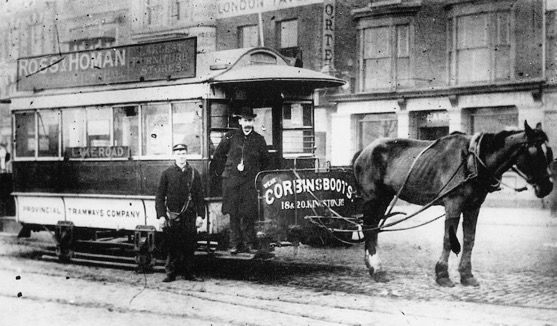
A conductor and a driver pose with an unidentified horsecar on a service from The Hard to Lake Road — photo purportedly taken in 1881. Photo courtesy of the Tramways and Light Railway Society, with thanks to David Voice.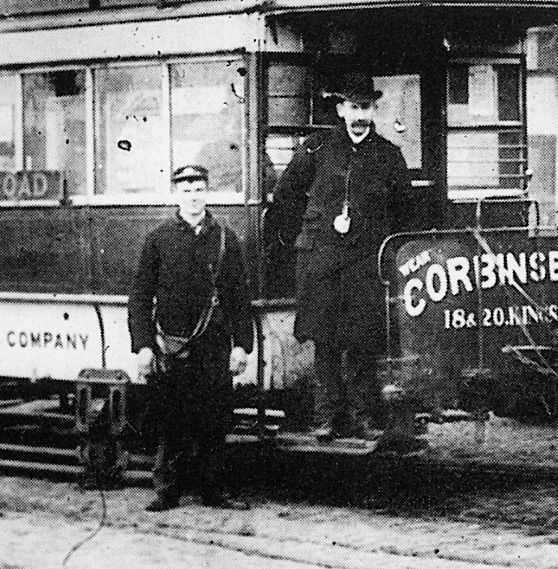
An enlargement of the above photograph, which shows that the driver is wearing a bowler hat with an upturned brim (characteristic of the 1880s), whilst the conductor is wearing a squat kepi-style cap bearing a small cap badge. The driver is also wearing a round licence badge.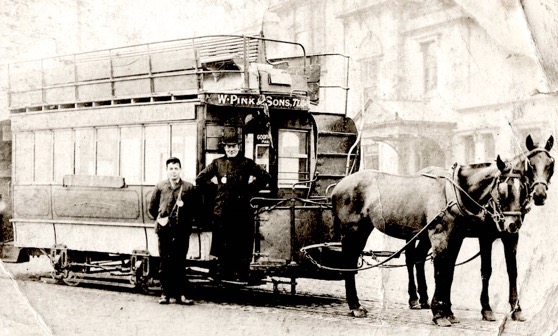
An unidentified and somewhat battered PSTCo tramcar and crew — photo undated, but possibly taken in the late 1880s or early 1890s. Author's Collection.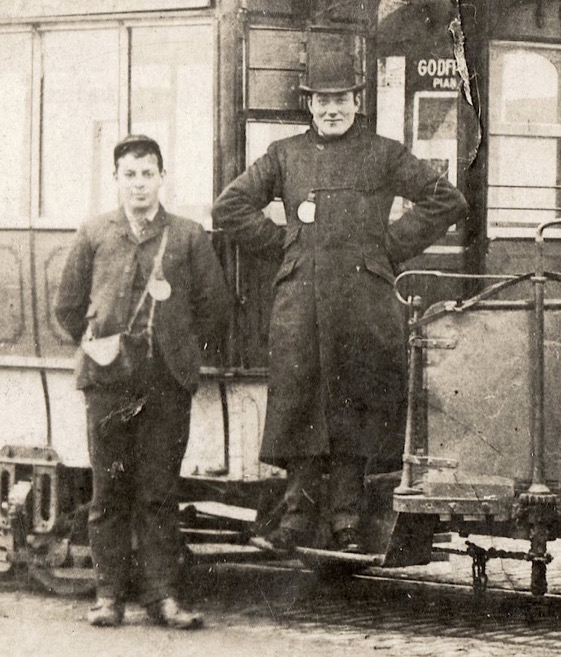
An enlargement of the above photograph showing the crew, the conductor in kepi-style cap and informal jacket, the driver in a long coachman's coat with a bowler hat; both men are wearing licence badges.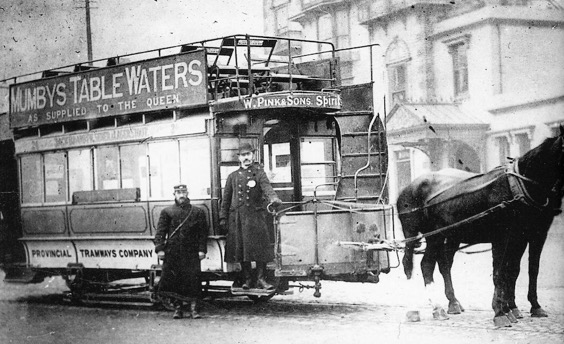
A conductor and a driver pose with an unidentified horsecar — photo undated, but definitely no earlier than 1890 when this class of car was first introduced. Photo courtesy of the Tramways and Light Railway Society, with thanks to David Voice.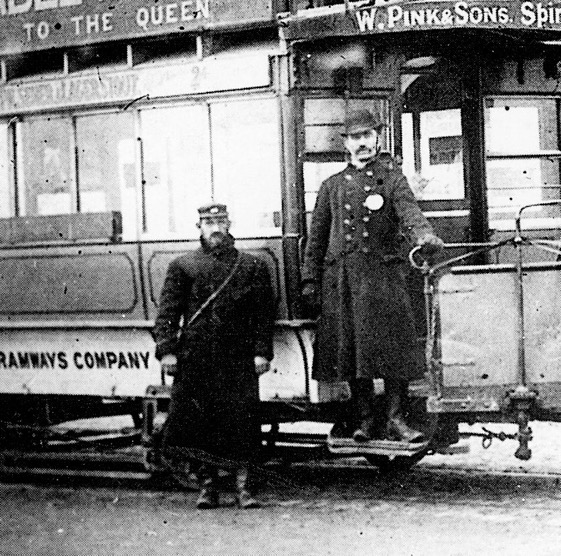
An enlargement of the above photograph. Once again the driver is wearing a bowler hat and the conductor a squat kepi-style cap bearing a small cap badge.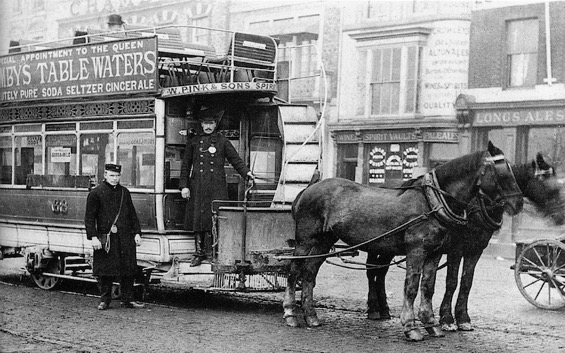
The conductor and driver of Horsecar No 68 captured for posterity — photo undated, but definitely taken after 1894 as No 68 was only built in that year. Photo courtesy of the Tramways and Light Railway Society, with thanks to David Voice.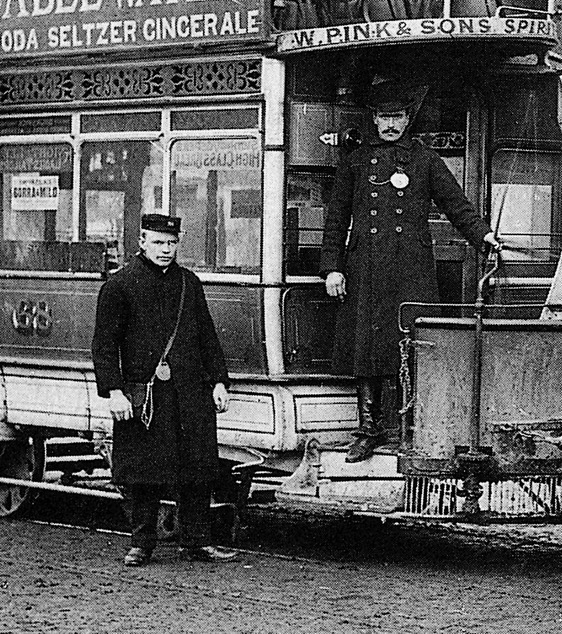
An enlargement of the above photograph showing the conductor and the driver; whilst the former sports a bowler hat, the latter has the usual squat kepi-style cap bearing, possibly bearing a small badge. Both men are wearing large round municipal licence badges.
Steam tram drivers and conductors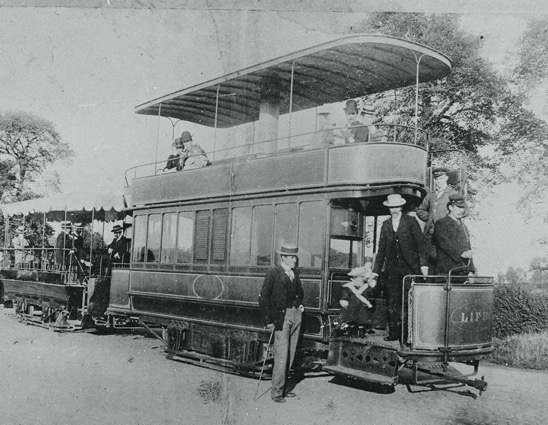
A well-known shot of the LIFU steam tram operating on the Landport and Southsea route — photo undated, but almost certainly taken shortly after its delivery in 1896. Photo courtesy of the National Tramway Museum. 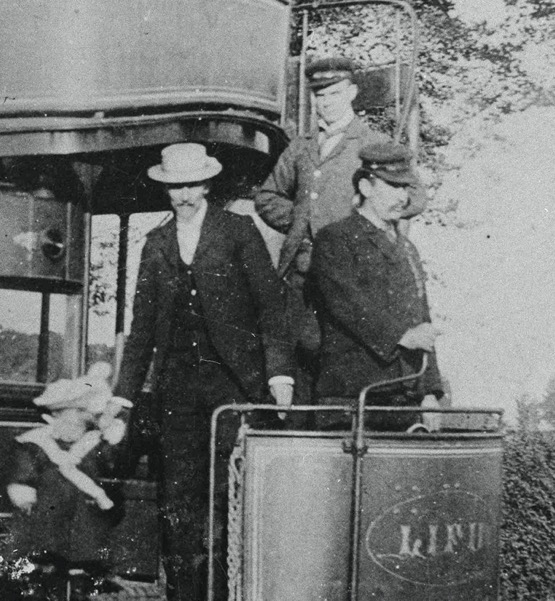
An enlargement of the above photograph showing the driver and the conductor (possibly). Both men appear to be wearing informal attire, almost certainly self-purchased, with soft-topped caps, the entire ensemble devoid of insignia, including licence badges.